 W
W69 is a roman à clef novel by Ryu Murakami. It was published first in 1987. It takes place in 1969, and tells the story of some high school students coming of age in an obscure Japanese city who try to mimic the counter-culture movements taking place in Tokyo and other parts of the world.
 W
WAfter the Banquet is a 1960 novel by Yukio Mishima.
 W
WA Certain Woman is the English translation of the name a Japanese novel by Arishima Takeo published in 1919. The first half of the novel first appeared in serialized form in the literary magazine Shirakaba , starting from January 1911 and running for 16 episodes to March 1913. The second half of the novel was not published until 1919, when both volumes were issued as a set.
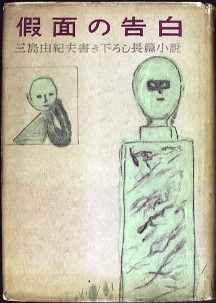 W
WConfessions of a Mask is Japanese author Yukio Mishima's second novel. First published in 1949, it launched him to national fame though he was only in his early twenties.
 W
WA Dark Night's Passing is the only full-length novel by Japanese writer Shiga Naoya. It was written in serialized form and published in Kaizō in between 1921 and 1937. The story follows the life of a wealthy, young Japanese writer in the early 1900s, who seeks to escape his unhappiness through marriage.
 W
WThe Day He Himself Shall Wipe My Tears Away is a novella by the Japanese author Kenzaburō Ōe, first published in Japanese in 1972. It has been translated into English by John Nathan and was published in 1977 together with Teach Us to Outgrow Our Madness, Prize Stock and Aghwee the Sky Monster. The work deals with themes of militarism and emperor-worship through the reminiscences of an unreliable narrator.
 W
WDevilman is a Japanese manga series written and illustrated by Go Nagai, which originally started as an anime adaptation of the concept of Nagai's previous manga series, Demon Lord Dante. Devilman's 39-episode anime series was developed by Toei Animation in 1972, while Nagai began the Devilman as a manga in Kodansha's Weekly Shōnen Magazine, barely a month before the anime series started. The series has since spawned numerous OVAs, manga, novels, films, and a sequel.
 W
WThe Doctor's Wife, known in Japanese as Hanaoka Seishū's Wife , is a noted novel by Sawako Ariyoshi written in 1966.
 W
WFires on the Plain is a Yomiuri Prize-winning novel by Ooka Shohei, published in 1951. It describes the experiences of a soldier of the routed Imperial Japanese Army in the Philippines, as part of the Battle of Leyte and the Battle of Ormoc Bay, at the end of 1944, towards the final months of World War II.
 W
WForbidden Colors is a 1951 novel by the Japanese writer Yukio Mishima, translated into English in 1968. The name kinjiki is a euphemism for homosexuality. The kanji 禁 means "forbidden" and 色 in this case means "erotic love", although it can also mean "color". The word "kinjiki" also means colors that were forbidden to be worn by people of various ranks in the Japanese court. It describes a marriage of a gay man to a young woman. Like Mishima's earlier novel Confessions of a Mask, it is generally considered somewhat autobiographical.
 W
WGate Keepers is a role-playing video game developed by Entertainment Software Publishing and published by Kadokawa Shoten for the PlayStation. The game was then adapted into a manga series written by Hiroshi Yamaguchi and drawn by Keiji Gotoh and an anime series produced by Gonzo, and first aired on April 3, 2000. A six episode original video animation (OVA) sequel, Gate Keepers 21, was released in 2002. The main characters in the OVA sequel were the next generation of Gate Keepers.
 W
WKani Kōsen is a 1929 novel by Japanese author Takiji Kobayashi.
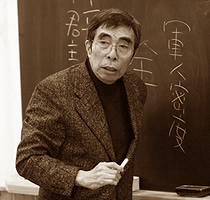 W
WInoue Hisashi was a leading Japanese playwright and writer of comic fiction. From 1961 to 1986, he used the pen name of Uchiyama Hisashi.
 W
WThe Lake is a short 1954 novel by the Japanese writer Yasunari Kawabata. This book tells the story of a former schoolteacher named Gimpei Momoi.
 W
WLife for Sale is a 1968 novel by Yukio Mishima. It was first serialised twenty-one times in the weekly magazine Weekly Playboy between 21 May 1968 and 8 October 1968. It was published in hardcover format by Shueisha on 25 December 1968. It was published in paperback by Chikuma Bunko on 24 February 1998. The novel was translated into English by Stephen Dodd and published in paperback format in the United Kingdom by Penguin Classics on 1 August 2019. The English translation received a wider release in paperback by Vintage International on 21 April 2020.
 W
WThe Master of Go is a novel by the Japanese author Yasunari Kawabata, who was awarded the Nobel Prize in Literature in 1968. The novel was first published in serial form in 1951. Titled Meijin (名人) in its original Japanese, Kawabata considered it his finest work, although it is in contrast with his other works. It is the only one of Kawabata's novels that the author considered to be finished.
 W
WMusubi no Yama Hiroku is an epic historical fantasy novel by Ryō Hanmura. It is a multi-generational saga reinterpreting 400 years of Japan's history through the perspective of a secretive family with mystical capabilities.
 W
WNo Longer Human is a 1948 Japanese novel by Osamu Dazai. It is considered Dazai's masterpiece and ranks as the second-best selling novel ever in Japan, behind Natsume Sōseki's Kokoro. The literal translation of the title, discussed by Donald Keene in his preface to the English translation, is "Disqualified From Being Human". The novel, narrated in first person, contains several elements which portray an autobiographical basis, such as suicide, a recurring theme in the author's life. Many believe the book to have been his will, as Dazai took his own life shortly after the last part of the book was published.
 W
WOtogi-zōshi (お伽草紙) is a Japanese collection of short stories by Osamu Dazai. In this work, the author is giving the reader a reinterpretation of classic Japanese fairy tales such as Urashima Taro, Tanuki and the Rabbit, Tale of a man with a wen and the Tongue-cut Sparrow, and gives the characters a new dimension which go against the national spirit which the Imperial Japanese Government was trying to foster.
 W
WA Personal Matter is a novel by Japanese writer Kenzaburō Ōe. Written in 1964, the novel is semi-autobiographical and dark in tone. It tells the story of Bird, a man who must come to terms with the birth of his mentally disabled son.
 W
WSabu to Ichi Torimono Hikae , sometimes translated as Sabu and Ichi's Detective Stories/Tales and Sabu and Ichi's Arrest Warrant, is a manga series by Shotaro Ishimori originally published in Weekly Shōnen Sunday from 1966 to 1967. In April 1968, the series moved to serialization in the first issue of Big Comic, where it was published until the series ended four years later in the April 10, 1972 issue.
 W
WSeason of the Sun is a Japanese novel written in 1955 by Shintaro Ishihara, who later became a politician and was governor of Tokyo for 13 years from 1999 to 2012. It is the source of the name of the rebellious taiyōzoku (太陽族) youth culture which emerged after World War II. The novel won the 1956 Akutagawa Prize.
 W
WThe Setting Sun is a Japanese novel by Osamu Dazai. It was published in 1947 and is set in Japan after World War II. Principal characters are Kazuko, her brother Naoji, and their elderly mother. The story shows a family in decline and crisis, like many other families during this period of transition between traditional Japan and a more advanced, industrial society. Many families needed to leave their old lives behind and start anew. Throughout the story, mostly through the character Naoji, the author brings up a number of social and philosophical problems of that time period.
 W
WShinobi no Mono (忍びの者) is a series of jidaigeki novels written by Tomoyoshi Murayama originally serialized in the Sunday edition of the newspaper Akahata from November 1960 to May 1962. Shinobi no mono is the long form of the phrase meaning ninja, see the Ninja article for details.
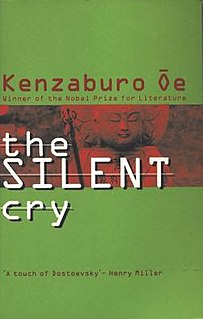 W
WThe Silent Cry is a novel by Japanese author Kenzaburō Ōe, first published in Japanese in 1967 and awarded the Tanizaki Prize that year.
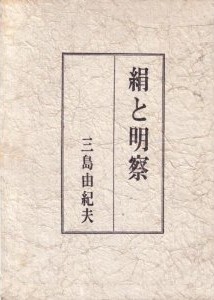 W
WSilk and Insight is a 1964 novel by the Japanese writer Yukio Mishima. The subject of the novel is taken from an actual strike in Japan in 1954 at Omi Kenshi, a silk thread and fabric manufacturer, which lasted for 106 days. The novel was first serialised in the monthly magazine Gunzo between January–October 1964. It was published in hardcover format by Kodansha on 15 October 1964. It was translated into English in 1998 by Hiroaki Sato.
 W
WThe Sound of Waves is a 1954 novel by the Japanese author Yukio Mishima. It is a coming-of-age story of the protagonist Shinji and his romance with Hatsue, the beautiful daughter of the wealthy ship owner Terukichi. For this book, Mishima was awarded the Shincho Prize from Shinchosha Publishing in 1954. It has been adapted for film five times.
 W
WThirst for Love is a 1950 novel by the Japanese writer Yukio Mishima. The word "kawaki" literally means thirst, but has a sense of parched dryness associated with it.
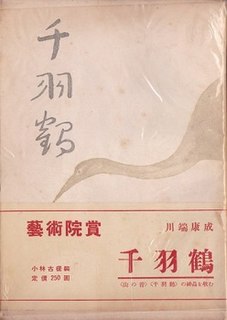 W
WThousand Cranes is a 1952 novel by Japanese author Yasunari Kawabata. The novel is divided into five episodes: "Thousand Cranes", "The Grove in the Evening Sun", "Figured Shino", "Her Mother's Lipstick" and "Double Star".